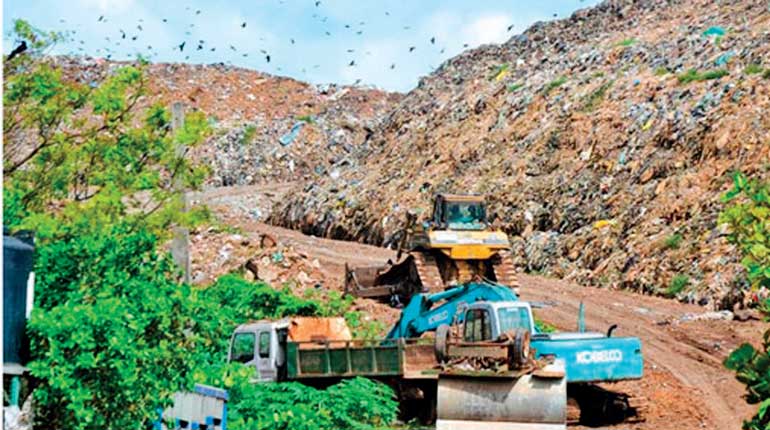Sunday Jan 11, 2026
Sunday Jan 11, 2026
Wednesday, 24 August 2016 00:01 - - {{hitsCtrl.values.hits}}

By U. Warnakulasooriya
Piles of garbage seen about in public places is a measure of a nation’s poverty, its bad politics and inefficient administration on the one hand and the erosion of civility and moral standards of its people on the other.
The wretched garbage dump at Meetotamulla-Pothuwila marshy land is a case in point that goes on regardless of health hazards, collateral damage and social issues that it entails.
Following a court order that decreed Meetotamulla as the destination for the voluminous Colombo city garbage, it grew at a rate of over 1,000 metric tons of assorted garbage per day into a monstrous mountain. Judging by the size, slant and shape of the dump it is obvious that the dumping goes on haphazardly without concern for the carrying capacity of the site in terms field coverage, dump height and geological implications, etc.
In the world’s major cities, garbage disposal is so well managed that the city dwellers do not even feel the presence of garbage dumps in their midst. However, compared with the developed world, we in Sri Lanka are far behind and simply pedestrian in our approaches to garbage management.
Among the plans to deal with the problem of Meetotamulla garbage dump is a proposal to move it out to another location in Puttalam by rail for a vast landfill but it is only wishful to think that such a solution would ever materialise given the costs involved, public protests already brewing at the proposed destination and the complexity of operations involving long distance transportation, etc. To usher in foreign investors to undertake recycling of garbage is another proposal that has been talked about for several years now.
Let such multi-billion exotic proposals take their own course and let’s think of some low-cost alternatives. For instance, ‘do as we do at home’ may be a first step towards bringing about some order in the haphazard dumping at the Meetotamulla site. This common sense approach to keep the soggy, messy and nauseating garbage closed under cover by using a garbage bin would tell us about some of the essential characteristics which the Meetotamulla dump is lacking at present. It does not have clearly-defined boundaries, the maximum height and the ideal shape of the dump, so that none would know its carrying capacity as of now or in time to come.
The authorities do not seem to have recognised that there is a range of rock-like highlands, which could be used as a natural boundary wall the highest point of which is where the Meetotamulla CTB depot is located. Beginning from its lowest point at Rahula Vidayalaya Meetotamulla, a man-made wall can be built so that what has long been an eyesore known as Kunu Kanda (garbage mountain) can be turned into a tank-like enclosure. The wall may be about 10-15 ft. in height and 600 meters in length, along the Wellampitiya-Avissawella Road as well as on its Meetotamulla Road boundary. It can be constructed out of poured or precast concrete. Alternatively, discarded cargo containers may be used to make the process of construction even quicker and more cost efficient.
There were squatters living in the Meetotamulla CTB depot foothills who have been evacuated recently for fear of impending collapse of the garbage dump. It has therefore become possible to flatten the pyramid-like dump cap towards where the squatters once lived and level it off evenly within the enclosure. New dumping should be done horizontally instead of heaping up garbage vertically. The flat dump to be created in this manner can be covered with foldable field covers like in a cricket ground until such time as permanent metal roofing is built later.
The result of all this will be that there won’t be an unsightly mountain of garbage to be seen or foul smells felt by the residents of the area.
The Government may commence a parallel program of recycling with foreign investors which will generate substantial employment opportunities for the people of the Kolonnawa area. Consider that there is a stock of about four million metric tons of solidified garbage already for recycling at the Meetotamulla dump-site. A part of the present Meetotamulla CTB Depot complex could be used for this purpose by shifting its bus parking facility to the vacant land at Kolonnawa-Salamulla-Vijaya Road junction. The existing CTB bus repair facility and its office premises may continue as it is.
Meanwhile, it would do well if the Government considers the ways and means of improving the quality of garbage reaching the dump-site by providing the households with a simple type of dryer working on liquid gas for drying of their degradable soggy garbage at home itself. The bulk producers of large quantities of garbage such as hospitals, hostels and hotels, etc., should be requested to put their soggy garbage through a similar drying process before loading them into garbage trucks.